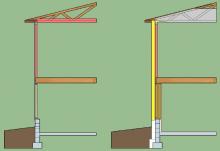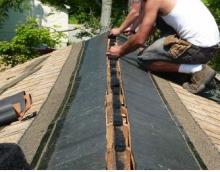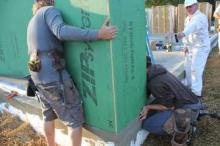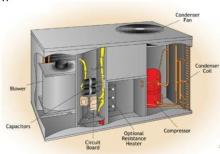Multifamily
Passive House Deep Energy Retrofits: Revitalizing Masonry Multifamily and Single Family Wood Frame Buildings
Michael Hindle and Matt Fine led a Passive House retrofit of three abandoned masonry apartment buildings on the Southeast side of Washington DC for low-income families. Designed to PHIUS+ standards, the renovation goal coupled with on-site renewables, and affordable housing tax credits, minimizes expenses for occupants - providing stability for resident families, while achieving nearly zero energy performance. The team designed and executed and external insulation strategy of I-joists and dense-pack fiberglass, with integrated window shading and airtightness. See the details, the processes and lessons learned.
Chris West bought a raised ranch house in Jericho, Vermont. Built in 1976 the house has standard 2x4 construction (16 oc) filled with fiberglass, single pane windows, and tuck under garage. In 2010 Chris took the Passive House training. Stuck with some earlier bad choices, and issues typical to every retrofit, see how he implemented Passive House methodology and calculations, to reduce the heating load of the house by 75%.
Building Science Puzzles
No matter how long you’ve been a building practitioner, you never stop encountering building science head-scratchers. Assemblies that you thought you had meticulously detailed may leak. Materials that you thought would last decades may show signs of pre-mature failure. Systems that seem like they should work (or have worked in the past) don’t. This workshop will teach you how to identify, diagnose and solve building science puzzles for a variety of building types, including residential, commercial and institutional, constructed using both traditional and modern methods. The presenters will share a series of case studies and invite the group to work together to identify the problems and propose solutions. Participants will also have an opportunity to present their own puzzles for group discussion.
The Elephant in the Room: How to Affordably Increase the Energy Efficiency of Our Existing Housing Stock
The biggest hurdle for energy efficiency in the built environment today is how to improve the energy efficiency of our existing housing stock in an affordable manner. These three practitioners bring several years of experience to the fore. They have seen what works, what doesn't, and why. The session will review the best building practices of how to view, evaluate and perform an energy upgrade to a property. Average square foot costs on energy efficiency return will be discussed and what can be the expected energy reductions from certain projects. This session will focus on some of the easier energy-efficiency upgrades to be taken now and what to put off to employ our next generation. Evaluation of the existing available financial resources to be used for offsetting the owner costs and how they might be improved. Lastly, they will address when a project is beyond the scope of affordability and what telltale signs to look for.
Roofs: Research and Reality
To vent or not to vent? To insulate outboard or inboard? To provide details or just let contractors wing it? These are some of the questions two pros, who spend a good portion of their work days crawling around on roofs (of both wood framed and masonry buildings), will address. They will share case studies of roof failures; go over edge and penetration details that are so critical for long-term durability; discuss how to take advantage of opportunities to improve thermal performance; and share some of the latest geeky research, including how to do an unvented assembly without code-mandated spray foam. You’ll leave this session knowing what works, what doesn't, and how to juggle budgetary, design or building constraints to build durable, low-risk roofs.
Passiv for the Masses
Climate change has made mainstream adoption of high-performance buildings a priority, and the Passivhaus standard provides a means to assess and drive the performance of these buildings. With 16 certified Passivhaus buildings between them, industry leaders Adam Cohen, Alan Gibson and Mathew Omalia will discuss their experiences designing and constructing a wide spectrum of building types, styles and scales that meet the Passivhaus standard. Adam Cohen will discuss techniques used to design, manufacture and construct Passivhaus buildings that cost the same or less than comparable code buildings. Alan Gibson will talk about simplifying construction systems and assemblies, and lessons learned about structure, moisture, air sealing, and air quality. Matt Omalia will explore how to integrate Passivhaus parameters into the design process to create a new canon of architectural design. The presenters will use case studies including: single and multi-family homes, schools, university residence halls, and community buildings.
Home Performance Insights from Big Data at NEST
Connected devices like the Nest Learning Thermostat provide an unprecedented amount of data about home energy usage patterns. This data can be used to further our understanding of how homes really work, and to help us identify both opportunities for and barriers to improving home performance. This session will present insights gleaned from analyzing large-scale anonymized data collected by Nest thermostats, and discuss the significance of these insights for the home performance industry. Topics to be addressed include: variations in HVAC run times with weather, real-world sizing of heating and cooling equipment, indoor temperature and humidity variations by season, and heat pump performance characteristics.
The True Performance of Your Hidden HVAC Equipment
How well does central ventilation equipment actually perform? VEIC and CLEAResult have respectively conducted field monitoring of Roof Top Units in commercial/institutional buildings and central Energy Recovery Ventilators in multifamily buildings. The outcomes? Although in certain cases not as bad as one would predict, this equipment is often underperforming, neglected, misunderstood, and installed and/or operated incorrectly. Come and learn more about our findings, how to improve current performance, and alternative design ideas to do it differently next time.
Passive House: Affordable, Retrofit, and Huge
Probably the most adopted newer certification in the building industry, Passive House is a US and international standard that small to very large owners are using to build and retrofit. Simple, affordable, and durable, this standard works in many types of buildings. Learn from four experienced practitioners about how smaller buildings are retrofitted, how affordable housing is built within budget, and how large scale dormitories and other buildings will be built in the future.
Benefits of Cx and RCx: Compliant Buildings, Healthy People
This discussion will examine multifamily and commercial commissioning and retro-commissioning projects with an emphasis on: code compliance; increasing energy savings; preventing building system failures; resolving operations and maintenance issues; and improving indoor environmental quality (IAQ). The session presentations will describe some of the most common aspects of buildings, such as ventilation, to lesser-known measures, like user tools and resources available in the marketplace to start commissioning buildings for compliance, efficiency, and health.
Airsealing and Firestopping: Smart Science
Air leaks cause comfort, energy, fire, durability, and vermin problems throughout buildings. Recent studies have shown that: stack effect losses in high rise buildings leak large amounts of treated air (who knew?); airsealing as part of new construction helps meet performance standards and increase comfort; and airsealing individual apartments as part of retrofit projects saves occupants money and increases comfort in those units. Listen to three diverse presentations on methods and results in airsealing projects.





